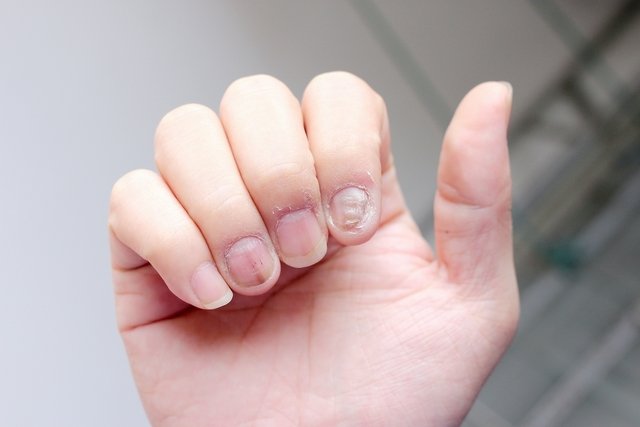Nail psoriasis, also called nail psoriasis, occurs when the body’s defense cells attack the nails, generating signs such as wavy, deformed, brittle, thick nails with white or brown spots.
Although there is no cure, the appearance of your nails can be improved by following treatment recommended by a dermatologist, which may include the use of nail polishes and ointments with substances containing clobetasol and vitamin D.
In addition, some treatments can be carried out at home, such as cleaning your nails, taking care of nail hydration and maintaining a diet rich in omega 3, such as flaxseed, salmon and tuna.

Main symptoms
The main symptoms of nail psoriasis are:
- Waves on the nails;
- Nails with deformities;
- Brittle and peeling nails;
- White or brown spots;
- Increased nail thickness;
- Nail detachment;
- Bleeding.
The symptoms of nail psoriasis can affect one or more nails and are similar to infections caused by fungi, such as mycoses, so as soon as changes in the nails appear, you should see a dermatologist to confirm the cause and start the most appropriate treatment.
How the diagnosis is made
The diagnosis of nail psoriasis is made by a dermatologist by observing the characteristics of the nails. Furthermore, to rule out a fungal infection in the nail, the doctor may recommend scraping or collecting a small piece of the nail to be evaluated in the laboratory.
Treatment options
Treatment for nail psoriasis must be guided by a dermatologist, as it can vary according to the number of nails affected, the person’s general health and the severity of the symptoms.
1. Nail polish
Nail psoriasis leaves the nails rough and softened, so some nail polishes can help with the treatment, improving the appearance of the nails, leaving them smoother and more resistant. Additionally, some types of nail polish may contain products such as vitamin D and clobetasol, which help to rebuild the nail. However, it is important to consult your doctor before applying nail polish to nails affected by psoriasis, as not all nail polish is beneficial.
2. Ointments
In milder cases of nail psoriasis, some types of ointments may be indicated that contain substances such as vitamin A, vitamin D, corticosteroids and immunosuppressants. These ointments must be recommended by a dermatologist and act by reducing inflammation and helping to restore the shape of the nail.
In some cases, when the nail lesions are larger and affect other areas of the body, such as the palms of the hands, these ointments are used in conjunction with some types of medication.
3. Medications
When psoriasis affects other areas of the body or when local treatment, with nail polish or ointments, does not bring results, medications such as methotrexate, cyclosporine, retinoids and corticosteroids are generally indicated. In general, these medications reduce the action of the body’s defense cells that are attacking the body itself, relieving symptoms.
In more advanced cases of nail psoriasis, the doctor may recommend corticosteroid injections, which are applied after local anesthesia. In addition, people with psoriasis should consult a rheumatologist to indicate the daily dose and duration of treatment with the medications.
4. Natural treatment
Some care can be taken at home to help treat nail psoriasis, such as keeping your nails short and clean. To clean your nails, you must use neutral and antibacterial soaps, in addition to avoiding the use of hard sponges or brushes with thick bristles, as this can cause bleeding on injured nails.
It is also recommended to use clippers instead of scissors, reducing the risk of further damaging your nails. Furthermore, it is necessary to keep your nails hydrated with suitable products recommended by your doctor, as this prevents nails with psoriasis from becoming ingrown.
5. Food
To control the symptoms of nail psoriasis, you should avoid foods that increase inflammation, such as red meat, sausages and canned foods, such as sausages, sausages and bacon, and foods rich in peppers and artificial preservatives.
Furthermore, it is important to increase your intake of fruits, vegetables and products rich in omega 3, such as flaxseed, salmon, tuna, walnuts and chestnuts. See more about other foods that help with psoriasis treatment.

Sign up for our newsletter and stay up to date with exclusive news
that can transform your routine!
Warning: Undefined array key "title" in /home/storelat/public_html/wp-content/plugins/link-whisper-premium/templates/frontend/related-posts.php on line 12
Warning: Undefined array key "title_tag" in /home/storelat/public_html/wp-content/plugins/link-whisper-premium/templates/frontend/related-posts.php on line 13



